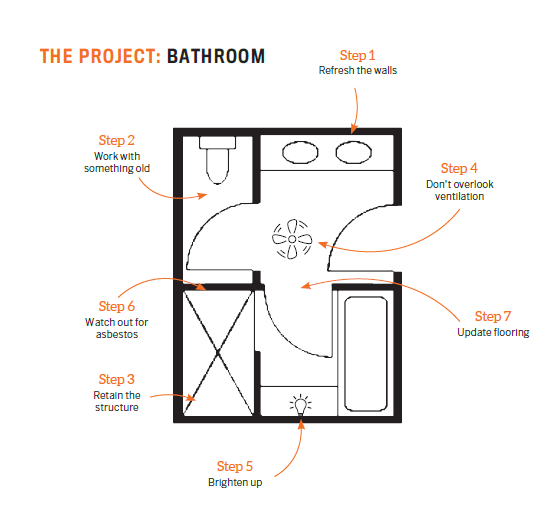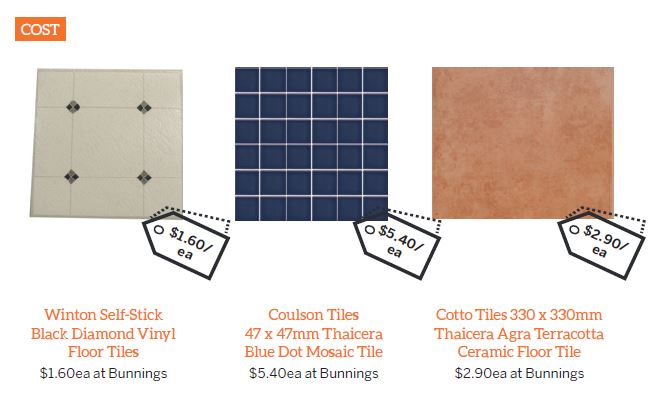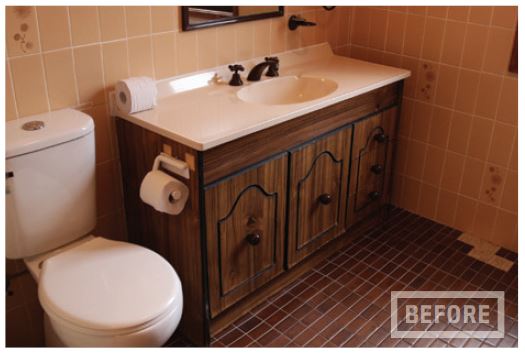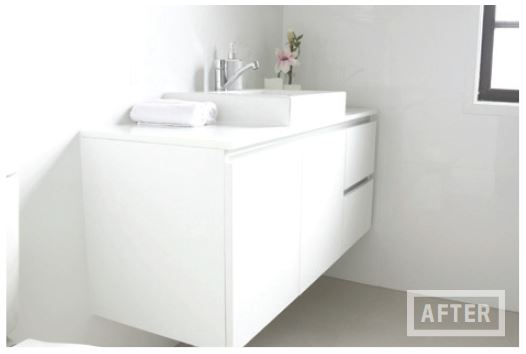The most expensive rooms to renovate in any house are usually the kitchen and bathrooms. Waterproofing, tiling, pipes and electrical work seem to collide in a perfect storm of high labour costs, which can turn even the smallest en suite refresh into a job worth more than $10,000.
But there are ways to renovate a bathroom smartly, efficiently, and for low cost. Just as importantly, you can do this while making an impact, which should be one of your key goals, says renovator Natalie Winter.
“Homebuyers today are consistently exposed to images of amazing homes through social media and programs like The Block,” she says. “This has made their expectations far greater than they ever used to be. Your renovation needs to stand out from the crowd.”
Going for impact doesn’t necessarily mean blowing your budget. However, it’s important to be strategic. Think along the lines of whether a purchase will help you generate a higher return, either on the rental or sale price, or if it’s merely a nice touch.
For instance, beautiful tiling will make a strong impact. But do you really need polished Carrara marble tiles, or are there other options you can install for a fraction of the price but that will still deliver a fantastic finish?
You absolutely can, which is why we’ve done some research for you on some smart strategies for renovating your bathroom.
“Expectations [are] far greater than they ever used to be. Your renovation needs to stand out from the crowd”
STEP ONE: REFRESH THE WALLS
Your bathroom walls don’t need to be bland, boring white slabs. Renovators are increasingly treating the walls as a work of art, with many modern bathroom fitouts showing a unique use of drywall tiles, ceramic tiles and even wooden detailing.
If you need to replace your bathroom’s drywall, it can actually be a blessing in disguise as it may give you the chance to do an appealing redesign. Upon removing the drywall, you’ll be able to see the framework of the room, and you can work with that to, say, move an entire window or toilet to maximise space, enhance the view, or let more natural light in.
Not everything you buy for your reno will actually be used, so give yourself the option of being able to return any excess materials and recoup some money.
STEP TWO: WORK WITH SOMETHING OLD
If something isn’t broken and does not affect your overall design vision, why replace it completely?
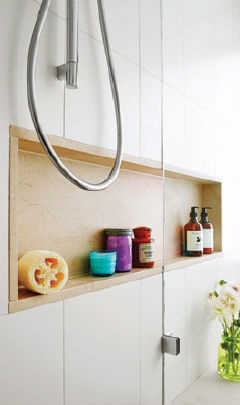
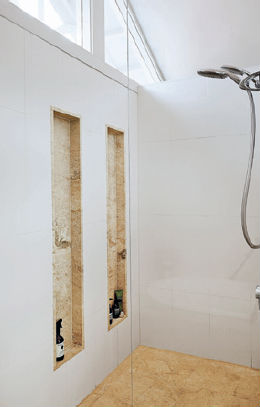
Some fixtures only need refinishing or re-enamelling to look like new, and it could help you save significantly on costs to refrain from buying all new materials. This is the ideal way to spruce up existing vanities, benches, bathtubs and even tiles.
If you must replace fixtures, don’t rip out the existing pieces with a heavy hand; you may be able to make a little money back from selling the old products online. There’s good demand for shower screens and vanities in particular.
Repurposed:
Old cabinet becomes tissue holder and old ladder a towel rack
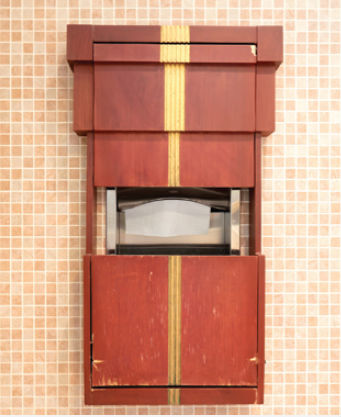
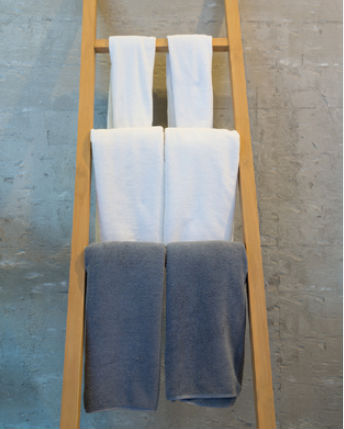
STEP THREE: RETAIN THE STRUCTURE
If your bathroom requires refreshing and a simple respray won’t do the trick, then consider upgrading your existing benches, showers and bathtubs in their current configuration.
Moving windows and door frames is usually quite straightforward, but shifting the position of the shower is a whole different ball game. This is because, when it comes to pipework, once you start rearranging the room your labour and material costs start to increase.
The golden rule? Stick with the structure as it is, and upgrade from there.

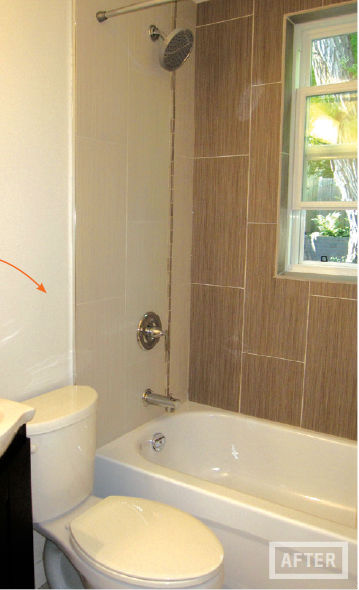
Be sure to buy products that meet Australian standards, such as bathroom fixtures that are covered by the Australian Standards WaterMark; without this, they cannot be legally installed.
STEP FOUR: DON’T OVERLOOK VENTILATION
Many things can damage your nice new bathroom as quickly as you installed it, including water lines, condensation and mould on the ceiling. So choosing a good exhaust fan is a must.
The fan should be big enough to effectively dry the space out quickly after a hot shower, and it is better to go a bit bigger than recommended to be sure it will do so.
Also, be sure to paint with a semigloss finish that has minimum sheen; this is perfect for bathroom walls as it is easy to wipe clean after condensation.
STEP FIVE: BRIGHTEN UP
A bathroom bathed in natural light is a beautiful space, so try to allow as much sunlight as you can into the room. The sun will set at some point, though, so it’s also important to install good lighting.
The general rule is to avoid very harsh lights in a bathroom space, while also ensuring it is bright enough to apply makeup. And of course it will all need to be waterproof.
This is not an area in which you should attempt a DIY job, so when installing new lights be sure to use a qualified electrician.
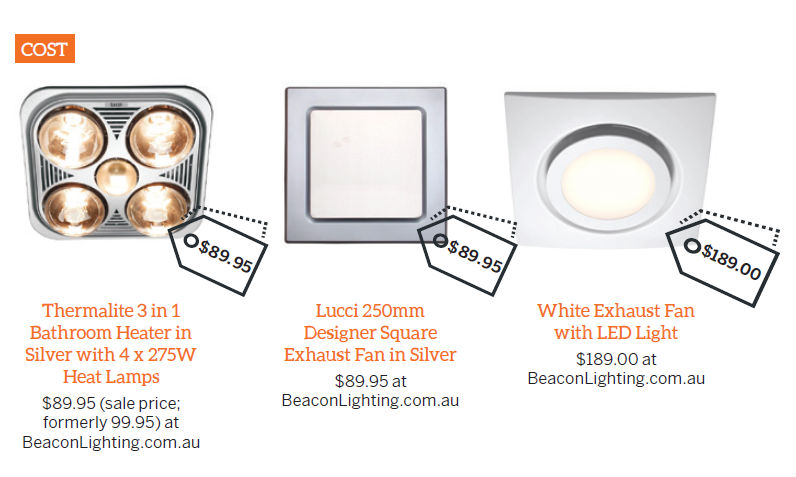
STEP SIX: WATCH OUT FOR ASBESTOS
When you’re renovating in a property built prior to 1984, asbestos is definitely a concern, especially in the bathroom walls. Modern homes are not necessarily safe from asbestos either, so be sure to have a chat with your builder or designer about whether you’re at risk.
You can get a licensed specialist to supervise the asbestos removal process, and there are also kits you can use to check for asbestos, or to safely remove it.

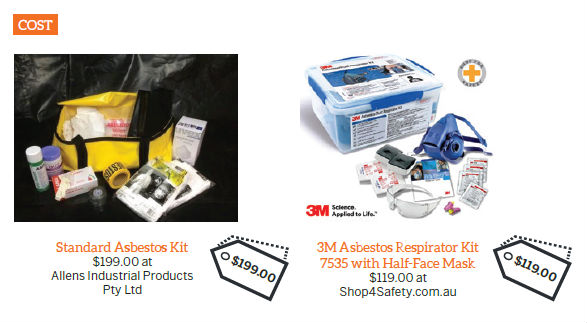
STEP SEVEN: UPDATE FLOORING
It doesn’t matter how beautiful the rest of the bathroom looks; if the flooring is dodgy, it lets the whole room down. Dark, dirty, outdated tiles draw the eyes downward and can detract from the amazing results you’ve achieved elsewhere with your renovation.
It’s easy to get distracted by the many attractive flooring options out there, but it’s essential to remember that bathroom flooring must, first and foremost, be able to withstand changes in temperature and constant exposure to water.
Tile, concrete and vinyl flooring are ideal for their many designs and long-term durability. Natural stone is excellent as well, though expensive.
Renovator Naomi Findlay, who favours a rapid-renovation style, recently embarked on a swift, successful bathroom reno in a property on the far south side of Sydney, in the Sutherland Shire.
“The property was around 80 years of age and appeared to have had some alterations and an extension completed in the ’80s. It was in very neat condition, but it was oozing with opportunities to add value,” Naomi says.
“There were many elements of the property that needed to be renovated, especially the outdated ’80s bathroom with the oversized spa and wood-panelled vanity!”
Knowing that it was essential to find the balance between over- and under-capitalising within their budget, Naomi says they aimed to hit the ‘sweet spot’ where their upgrades could drive the maximum increase in property value and rental yield.
“I had costed the budget for the work at $7,470, and the actual work came in at $7,802, so there was a 4.4% cost variation,” she says.
“The biggest splurge would have to be the large wall-hung vanity and the reinforcement of the wall to allow for its installation, along with some really quality classic tiles. That said, the best bargain in the space was defi nitely being able to reuse the existing toilet, with no changes to the plumbing at all. It came out clean and went back in like a dream!”
While their dream scenario would have included a separate shower added to the space, Naomi says space constraints were too tight. So she thought a little outside the square.
“To counter that, I installed one into the laundry instead, to make sure that I had met the needs of the target market,” she says.
The renovation “absolutely” boosted the property’s value, Naomi adds.
“There was a 34% increase on the rental yield post-renovation, and there was a minimum two-for-one return on every dollar invested when you looked at the
value of the property and the equity that this renovation added.
“Also, very importantly, it made the property infi nitely more appealing to the target rental market.”
 Naomi Findlay
Naomi Findlay
is the CEO of Silk Home and
principal and founder of the
International Institute of Home Staging
Disclaimer: All products and prices listed are correct at time of printing.
The advice contained in this article is for general information only and should not be taken as fi nancial advice.
Please make sure to speak to a qualifi ed professional person before making any investment decision.
